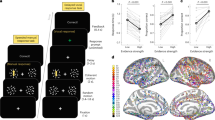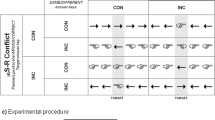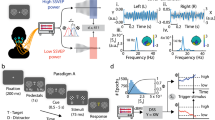Abstract
WALTER et al.1 observed that when a human subject is presented with two sequentially paired stimuli so that the first serves to signal the occurrence of the second, a negative d.c. shift occurs during the interval between the stimuli in an averaged scalp EEG recording; he termed this phenomenon the “contingent negative variation” (CNV). CNV is frequently elicited with fixed foreperiod decision tasks, which may be said to include a “hold” phase, from the warning signal (WS) to the task stimulus (TS), and an “operate” phase, following the TS and terminating with the subject's response (R) to the TS (Fig. 1). CNV definitely occurs during the hold phase, so long as the subject is motivated and the task is sufficiently difficult2–6, but it has not been demonstrated that CNV is present during the operate phase. The tasks used in previous experiments have been so simple that TS and R occurred virtually simultaneously, and it could not be determined whether the termination of CNV covaries with the TS (the end of the hold phase) or with R (the end of the operate phase). In these experiments CNV was averaged during several complex cognitive tasks with considerably longer operate phases, and found to persist throughout the operate phase, for periods ranging up to 8 s after the TS.
This is a preview of subscription content, access via your institution
Access options
Subscribe to this journal
Receive 51 print issues and online access
$199.00 per year
only $3.90 per issue
Buy this article
- Purchase on Springer Link
- Instant access to full article PDF
Prices may be subject to local taxes which are calculated during checkout
Similar content being viewed by others
References
Walter, W. G., Cooper, R., Aldridge, V. J., McCallum, W. C., and Winter, A. L., Nature, 203, 380 (1964).
McAdam, D. W., Psychon. Sci., 6, 436 (1966).
Low, M. D., Frost, J. D., Borda, R. P., and Kellaway, P., Electroenceph. Clin. Neurophysiol., 21, 413 (1966).
Irwin, D. A., Rebert, C. S., McAdam, D. W., and Knott, J. R., Eletroenceph. Clin. Neurophysiol., 21, 412 (1966).
McAdam, D. W., Irwin, D. A., Rebert, C. S., and Knott, J. R., Electroenceph. Clin. Neurophysiol., 21, 194 (1966).
Rebert, C. S., McAdam, D. W., Knott, J. R., and Irwin, D. A., J. Comp. Physiol. Psychol., 63, 20 (1967).
Hillyard, S., Physiol. Behav., 4, 351 (1969).
Clynes, M., Kohn, M., and Lifshitz, K., Ann. NY Acad. Sci., 112, 468 (1964).
Rowland, V., Electroenceph. Clin. Neurophysiol., 15, 474 (1963).
Rowland, V., in Symposium on Activation (AAAS, Montreal, 1964).
Ritter, W., Vaughan, H. G., and Costa, L. D., Electroenceph. Clin. Neurophysiol., 25, 550 (1968).
Kornhuber, H. H., and Deecke, L., Pflügers Arch., 284, 1 (1965).
Gilden, L., Vaughan, H. G., and Costa, L. D., Electroenceph. Clin. Neurophysiol., 20, 433 (1966).
Walter, W. G., J. Psychosom. Res., 9, 51 (1965).
Tecce, J. J., and Scheff, N. M., Science, 164, 331 (1969).
Author information
Authors and Affiliations
Rights and permissions
About this article
Cite this article
DONALD, M. Direct-current Potentials in the Human Brain evoked during Timed Cognitive Performance. Nature 227, 1057–1058 (1970). https://doi.org/10.1038/2271057a0
Received:
Revised:
Issue Date:
DOI: https://doi.org/10.1038/2271057a0
Comments
By submitting a comment you agree to abide by our Terms and Community Guidelines. If you find something abusive or that does not comply with our terms or guidelines please flag it as inappropriate.



